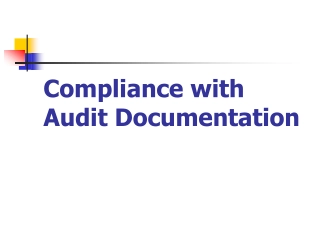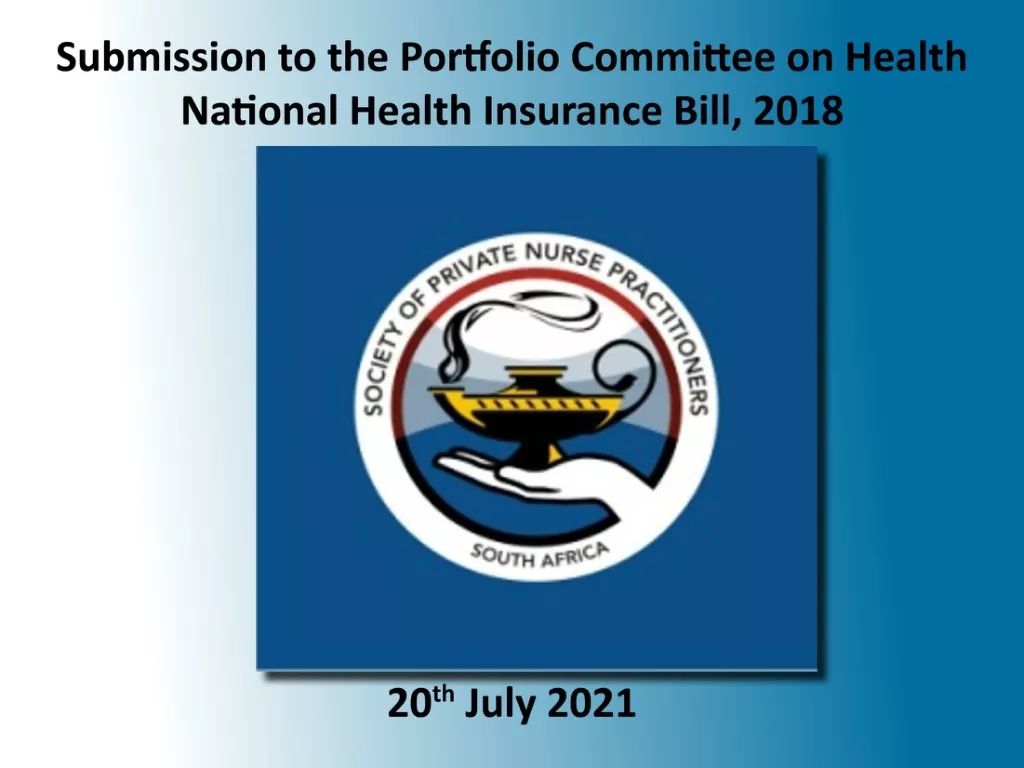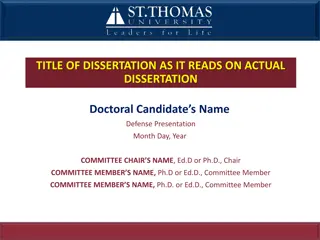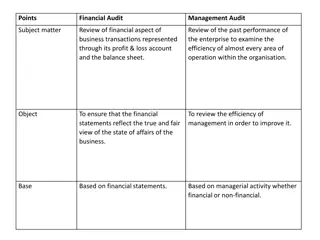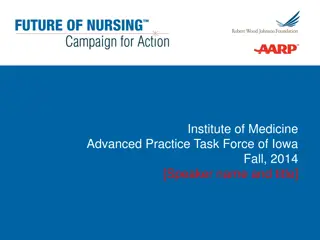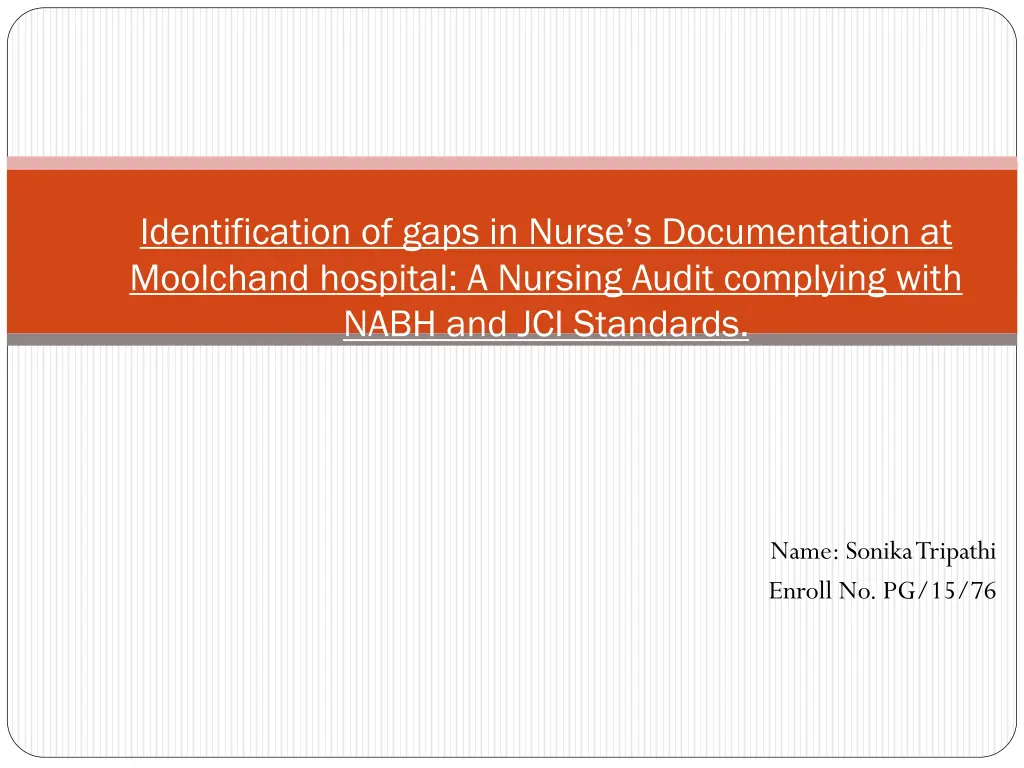
Nursing Audit for Improving Documentation Compliance in Healthcare
Enhance nursing documentation compliance with NABH and JCI standards through a comprehensive nursing audit at Moolchand Hospital. Discover gaps, improve patient care, and ensure accurate records for efficient healthcare delivery.
Download Presentation

Please find below an Image/Link to download the presentation.
The content on the website is provided AS IS for your information and personal use only. It may not be sold, licensed, or shared on other websites without obtaining consent from the author. If you encounter any issues during the download, it is possible that the publisher has removed the file from their server.
You are allowed to download the files provided on this website for personal or commercial use, subject to the condition that they are used lawfully. All files are the property of their respective owners.
The content on the website is provided AS IS for your information and personal use only. It may not be sold, licensed, or shared on other websites without obtaining consent from the author.
E N D
Presentation Transcript
Identification of gaps in Nurses Documentation at Moolchand hospital: A Nursing Audit complying with NABH and JCI Standards. Name: SonikaTripathi Enroll No. PG/15/76
INTRODUCTION Nurses are the backbone of the hospital. Starting from the entry of the patient in the ward till the discharge of the patient, nurses play a major role in the recovery of patient s condition. During the stay of the patient in the hospital, it is nurse s responsibility to document the care provided, e.g. medicines administered, vitals monitoring, Assessment of the patient etc. Nursing documentation in the patient records helps in continuity of care of the patient and helps to understand the course of treatment in the hospital
However ,with increase in workload, the importance of timely and accurate documentation in the patient records is sidelined and is often overlooked. This might lead to errors in the care processes,discrepancies in the hospital charges, and infringe on ethical and legal aspects of the category. Nursing Audit is defined as a review of the patient record designed to identify, examine, or verify the performance of certain specified aspects of nursing care by using established criteria. Purpose of nursing audit: Evaluation: Evaluating the nursing care given. Achieve deserved and feasible quality of nursing care. Verification: Stimulant to better records. Focuses on care provided and not on care provider. Contributes to research. Review of professional work or in other words the quality of nursing care i.e. we try to see how far the nurses have confirmed to the norms and standards of nursing practice while taking care of patients.
It encourages followers to be actively involved in the quality control process and better records. It clearly communicates standards of care to subordinates. Facilitates more efficient use of health resources. Helps in designing response orientation and in-service education programme Incomplete documentation by nurse s in the patients record can lead to: Unnecessary delays in diagnosis, treatment and care Repeated tests Missed or delayed communication of test results Incorrect treatment or medication errors.
The study was conducted over a period of three months at Moolchand Hospital to understand the gaps in the nursing documentation according to NABH and JCI standards in the IPD areas Nearly 254 Inpatient records were audited with the help of a nursing audit toolkit. Auditing of records was done on all the four inpatient floors of the hospital (First Floor, Ground Floor, Third Floor, International wing). Results indicated a lack of compliance in all the floors.
Accreditation boards recommend complete and legible documentation in the patient s record to facilitate quality patient care. JCI Recommendations: Standard IPSG.1 Identify patient correctly Use two identifiers other than room number. Standard IPSG.2 Improve effective communication IPSG.2.1 Verbal medication, non-medication orders and communication of test findings should be documented in the patient s record file. Standard IPSG.2.2 The hospital develops and implements a process for handover communication Standard IPSG.3 The hospital develops and implements a process to improve the safety of high-alert medications. Patient Centered Standard: Patient and family education: Patient and family should be educated about their disease process, proposed plan of care and effects, nutrition, medication. This must be documented in the case records
Patient Centered Standard: Patient and family education: Patient and family should be educated about their disease process, proposed plan of care and effects, nutrition, medication. This must be documented in the case records NABH Recommendations: Standard AAC5 Nurse assessment and nutrition screening should be done within 30 minutes of admission of the patient.
Objectives of the study: To identify the gaps in nursing documentation in IPD area of the hospital To suggest measures to improve timely and accurate documentation by nurses. Material and methods: Study Design: Cross sectional descriptive study. Setting: Moolchand Hospital, New Delhi. Duration of study: 6 February 2017 to 6 May 2017. Sample Size: Total 254(Patient record files) Ground floor- 58 First floor- 76 Third floor- 71 International wing- 49 Sampling Technique: Purposive sampling technique
Sample Selection: Inclusion criteria: Inpatient active files (files of currently admitted patients) on all the four floors of IPD including ground floor, first floor, third floor and International wing. Exclusion criteria: Inactive files (files already sent to medical records department post discharge). Data collection procedure: Primary data collection: Direct observation of the nursing assessment and vitals monitoring post new IPD admission on the floors. Secondary data collection: Daily audit of the inpatient records on the floors in IPD with the help of nursing audit toolkit.
List of documents audited during the study This form is filled when the patient is admitted in any of the wards. It contains vital signs, fall risk assessment, functional screening, nutritional screening, pain assessment etc. The assessment should be ideally done and documented within 30 minutes of admission. This form is filled by the nurses to document the daily patient care activities, investigations ordered, procedures ordered, Vital monitoring chart, safety measures taken. During shift change, nurses are supposed to sign for handing over and taking over of the patients. This record contains the details of items billed for the patient. During each shift, name and signature of nurse updating the BAR should be there. It contains the details of the medicines administered to the patient along with nurse s signature and time. In case of high risk medication administration, there should be a counter sign also. The verbal orders are documented with seal and verification signature of doctor is very important. This form has the details about the condition of the patient and on that basis family members are also educated about the prognosis of the condition .Also the precautions to be taken to help patient healthy recovery Nurse assessment form Daily patient care record Billing activity record Medical Administration record Patient and Family Education form Note: The above forms are attached daily in the patient record and are arranged date wise. Patient identifiers i.e Name and HUID are recorded in every document of the patient s file. The ID band is provided to patient in order to avoid any patient identification error
Data Analysis: The analysis is based on the scoring for documentation of 11 different parameters in patient record of Ground, First, Third floor and International Wing. The scoring criteria is as follows: Total compliance: Score 10 (When documentation is complete and is present in all the forms attached date wise in the file) Partial compliance: Score 5 (When documentation is present in two or more forms arranged date wise in the file) No compliance: Score 0 (When documentation is present in only one or less than one forms, arranged date wise in the record)
Findings: Following graphs shows the comparison between the floors regarding the compliance in documentation. 1.Initial assessment of patients within 30 minutes of admission % of cases with initial assessment of patients within 30 minutes of admission 100 90 80 70 % of Compliance 60 50 40 30.2 30 15.5 20 12.2 7 10 0 GF FF TF IW Floors Figure 1 The above figure shows that the compliance for initial assessment of patients is maximum in First floor (30.2 %), followed by Ground floor and International wing.Third floor has the least compliance (7%).
2. Nutritional Screening within 30 minutes of admission % of cases with nutritional screening within 30 minutes of admission 40 35 30 % of Comliance 25 20 15 7 10 6 3 2.6 5 0 GF FF TF IW Floors Figure 2 The above figure shows that Nutritional screening within 30 minutes is done only in 7% of the cases in Third floor, followed by International wing with 6% compliance. Ground floor and first floor have least compliance, about 3%
3.Vitals monitoring and documentation: % of cases with Vitals Monitoring and documentation 100 85 90 80 65 % of Compliance 70 60 51.3 50 40 26 30 20 10 0 GF FF TF IW Floors Figure3. shows that in almost in 85% of the cases, vitals monitoring and documentation is done on Third floor, However International wing is least compliant with vitals documentation i.e only 26 % of the cases.
4. Signatures in BAR sheet % of cases with signatures in BAR sheet 100 90 74.6 80 70 % of Compliance 58.6 60 48.6 50 42.8 40 30 20 10 0 GF FF TF IW Floors Figure 4: shows that Third floor has maximum compliance amongst all the floors regarding the signatures in BAR sheet (74.6%), followed by First floor (48.6%), IW and ground floor.
5. Nursing handover signatures % of cases with nursing Handover Signature 100 90 80 71 70 % of Compliance 53.4 60 50 39.5 32.6 40 30 20 10 0 GF FF TF IW Floors Figure 5:The above figure shows that Third floor has compliance in 71% of cases where nursing handover signatures are present.signatures in only 32.6% cases.
6. Documentation of Patient's Name % of cases with documentation of Patient 's Name 120 100 100 100 100 100 % of Compliance 80 60 40 20 0 GF FF TF IW Floors Figure 6 The above figure shows that all floors have 100% compliance of documentation of patient s name in the patient record file.
7. HUID documentation as patient identifier % of cases with identification of patient by HUID 120 100 100 100 100 100 % of Compliance 80 60 40 20 0 GF FF TF IW Floors Figure 7 The above figure shows that all floors have 100% compliance of documenting HUID as patient identifier.
8.Patient Identification by ID band % of cases with identification of patient by ID band 96.55 97.4 97 94 100 80 % of Compliance 60 40 20 0 GF FF TF IW Floors Figure8:The above figure shows that First floor has compliance in 97% of cases for identification of patient by ID band and least compliance in International wing (94%).
9. Documentation of Verbal/Stat order % of cases with documentation of verbal /stat order 80 67.92 70 62.67 56 60 49 % Compliance 50 40 30 20 10 0 GF FF TF IW Floors Figure 9 The above figure shows that Ground floor has compliance in 67% of cases of documentation of verbal/stat order with seal and doctor verification signature, first floor has compliance in 62% cases followed by International wing 56% and least compliance is of Third floor 49%.
10. Patient and family education documentation (procedure/proposed plan of care and effects of treatment) % of cases with of documentation in Patient & family education form 6 5.19 5 % compliance 4 3 1.72 2 1 0 0 0 GF FF TF IW Floors Figure 10 The above figure shows that compliance percentage for documentation of patient and family education is 5.2% in first floor records and no compliance score in case of third floor and International wing.
Results: Table 2: Percentage of compliance, partial compliance and non-compliance in nursing documentation of the 11 parameters, audited on various floors during the study. N=254 Audit Parameters % of compliance Compliant Floors Partially compliant 84.4 68.4 93 87 60.3 51.3 56.3 67.3 35 48.6 15 73 Non- compliant 0 0 0 0 36.6 46 36.6 26 0 0 0 0 GF FF TF IW GF FF TF IW GF FF TF IW 15.5 30.2 7 12.2 3 2.6 7 6 65 51.3 85 26 Initial patients in 30 minutes of admission assessment of Nutritional screening in 30 minutes of admission Vitals documentation in DPR monitoring and
GF FF TF IW GF FF TF IW GF FF TF IW 58.6 48.6 74.6 42.8 53.4 39.5 71 32.6 0 0 0 0 41.3 51.3 25.4 57.1 46.5 60.5 29 67.3 100 100 100 100 0 0 0 0 0 0 0 0 0 0 0 0 Signatures in BAR sheet Nursing handover signatures Nurse s sign and counter sign in case of high risk medication administration
GF FF TF IW GF FF TF IW GF FF TF IW GF FF TF IW GF FF TF IW 100 100 100 100 100 100 100 100 96.5 97 97 94 67.9 62.6 49 56 1.72 5.19 0 0 0 0 0 0 0 0 0 0 0 0 0 0 28.3 36 43 40 98.28 93.51 97 96 0 0 0 0 0 0 0 0 3.45 2.6 3 6 3.77 1.33 7 4 0 1.3 3 4 Documentation of Patients Name HUID documentation as patient identifier Patient Identification by ID band Documentation of Verbal/Stat order Patient and family education documentation
Interpretation: Compliance in documentation of vitals, Handover signatures, BAR sheet is maximum on Third floor (85%,71%, 74.6 % respectively) as compared to other floors. Initial assessment and nutritional screening are not done within 30 minutes in majority of the cases. Maximum compliance of initial assessment is seen in First floor (30%) and minimum is seen on Third floor (7%). Nutritional screening has lower compliance as compared to other parameters audited on GF, FF, TF, IW (3%, 2.6%, 7%, 6%) respectively. In all the cases with high risk medication administration, nurse s counter sign was missing. Hence there is 100% partial compliance with only one nurse signature on administration record
Documentation of Patients name and HUID has 100% compliance in records of the floors audited. Patient identification check by ID band is maximum followed by first floor (97.4%) followed by third floor (97%)and least compliance percentage is of International wing(94%). Patient and family education parameter has least percentage compliance as compared to other parameters. This parameter has partial compliance percentage higher than 100% compliance in all floors.
Conclusion: Quality nursing documentation promotes structured, consistent and effective communication between caregivers and facilitates continuity and individuality of care and safety of patients. The accuracy of documentation content in relation to patients actual conditions and the care given is an important process feature of documentation quality. From the study, it can be concluded that the nursing care was not fully expressed in the records, so written communication between different caregivers about patients was inadequate. Regular trainings on effective documentation and auditing the same are few measures which can be taken to improve the documentation process.
Suggestions: Education and training programs to be organized for nurses for timely and accurate documentation in the patient records. During the trainings. The nurses should be explained about the importance of documentation of the vitals and regular monitoring which may otherwise lead to unexpected outcome and compromised patient care leading to their dissatisfaction. They should be educated that if the BAR sheet is filled properly, it will help in reducing billing errors which in turn will reduce the revenue loss. Accountability of patient care during a particular shift depends on the assigned nurse, hence importance of documentation of handing over and taking over should be communicated to the nurses.
Nurses should be explained that if initial assessment and nutritional screening is not done within 30 minutes,there will be delay in the further treatment plan and it can have adverse outcomes. Regular monitoring and auditing to ensure complete documentation by the nurses. To conduct regular on the job training for the nurses.

